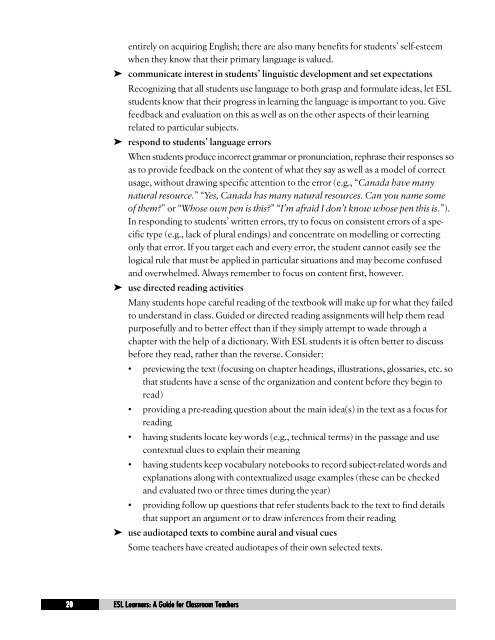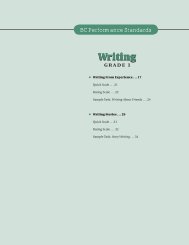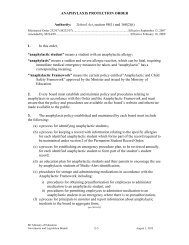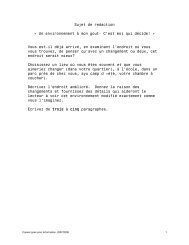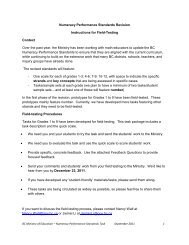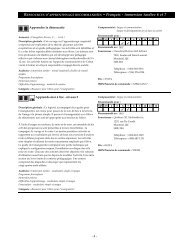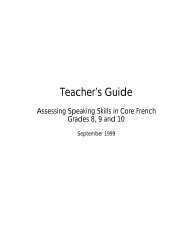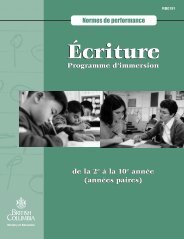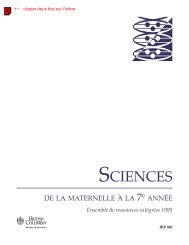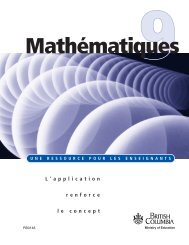A Guide for Classroom Teachers - Education
A Guide for Classroom Teachers - Education
A Guide for Classroom Teachers - Education
You also want an ePaper? Increase the reach of your titles
YUMPU automatically turns print PDFs into web optimized ePapers that Google loves.
20<br />
20<br />
entirely on acquiring English; there are also many benefits <strong>for</strong> students’ self-esteem<br />
when they know that their primary language is valued.<br />
➤ communicate interest in students’ linguistic development and set expectations<br />
Recognizing that all students use language to both grasp and <strong>for</strong>mulate ideas, let ESL<br />
students know that their progress in learning the language is important to you. Give<br />
feedback and evaluation on this as well as on the other aspects of their learning<br />
related to particular subjects.<br />
➤ respond to students’ language errors<br />
When students produce incorrect grammar or pronunciation, rephrase their responses so<br />
as to provide feedback on the content of what they say as well as a model of correct<br />
usage, without drawing specific attention to the error (e.g., “Canada have many<br />
natural resource.” “Yes, Canada has many natural resources. Can you name some<br />
of them?” or “Whose own pen is this?” “I’m afraid I don’t know whose pen this is.”).<br />
In responding to students’ written errors, try to focus on consistent errors of a specific<br />
type (e.g., lack of plural endings) and concentrate on modelling or correcting<br />
only that error. If you target each and every error, the student cannot easily see the<br />
logical rule that must be applied in particular situations and may become confused<br />
and overwhelmed. Always remember to focus on content first, however.<br />
➤ use directed reading activities<br />
Many students hope careful reading of the textbook will make up <strong>for</strong> what they failed<br />
to understand in class. <strong>Guide</strong>d or directed reading assignments will help them read<br />
purposefully and to better effect than if they simply attempt to wade through a<br />
chapter with the help of a dictionary. With ESL students it is often better to discuss<br />
be<strong>for</strong>e they read, rather than the reverse. Consider:<br />
• previewing the text (focusing on chapter headings, illustrations, glossaries, etc. so<br />
that students have a sense of the organization and content be<strong>for</strong>e they begin to<br />
read)<br />
• providing a pre-reading question about the main idea(s) in the text as a focus <strong>for</strong><br />
reading<br />
• having students locate key words (e.g., technical terms) in the passage and use<br />
contextual clues to explain their meaning<br />
• having students keep vocabulary notebooks to record subject-related words and<br />
explanations along with contextualized usage examples (these can be checked<br />
and evaluated two or three times during the year)<br />
• providing follow up questions that refer students back to the text to find details<br />
that support an argument or to draw inferences from their reading<br />
➤ use audiotaped texts to combine aural and visual cues<br />
Some teachers have created audiotapes of their own selected texts.<br />
ESL ESL Learners: Learners: A A <strong>Guide</strong> <strong>Guide</strong> <strong>for</strong> <strong>for</strong> <strong>Classroom</strong> <strong>Classroom</strong> <strong>Teachers</strong><br />
<strong>Teachers</strong>


